| View previous topic :: View next topic |
| Author |
Message |
prcantos
Site Admin
Joined: 17 Apr 2012
Posts: 243
Location: Granada (Spain)



|
 Posted: May 04, 2015 17:19 Post subject: Miller-Bravais Indices: really necessary? Posted: May 04, 2015 17:19 Post subject: Miller-Bravais Indices: really necessary? |
|
|
Hi. I wonder if the Miller-Bravais indices notation is really useful in Crystallography. In other words, what is the real utility of the extra index i in (hkil) in hexagonal and trigonal systems? The i-index is redundant because h+k+i=0, so you can always leave it out. Is there any heavy reason to keep it?
_________________
Pablo Rodríguez Cantos
Λίθον˛ον απεδοκίμασαν˛οι οικοδομουντες |
|
| Back to top |
|
 |
Pete Richards
Site Admin
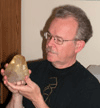
Joined: 29 Dec 2008
Posts: 828
Location: Northeast Ohio



|
 Posted: May 04, 2015 18:05 Post subject: Re: Miller-Bravais Indices: really necessary? Posted: May 04, 2015 18:05 Post subject: Re: Miller-Bravais Indices: really necessary? |
|
|
Thank you Pablo for raising an important question.
You are right that the third index i is redundant in the hexagonal/trigonal system referred to a hexagonal unit cell with a=b, beta=120°. Most recent authors that I am aware of (me included) are dropping this i index, but being careful to say that they are doing so, and why. For hexagonal minerals, this is pretty trivial. But for trigonal/rhombohedral minerals, there is another rhombohedral frame of reference that uses three equal axes separated by a rhombohedral angle alpha normally not equal to 90°. In the case of calcite, the three axes would be parallel to the edges of the cleavage rhombohedron, and the angle alpha would be the angle between each of these axes. This system is also written using {hkl} notation, but the numbers would be different from those with respect to the Miller-Bravais hexagonal cell setting.
The use of the rhombohedral cell setting is diminishing through time. I think (on minimal experience) that the strong-hold of this setting was England. But there is enough use of this frame of reference in the standard reference works that it is important to be clear which frame of reference one is using!
_________________
Collecting and studying crystals with interesting habits, twinning, and epitaxy |
|
| Back to top |
|
 |
Bob Carnein
Joined: 22 Aug 2013
Posts: 327
Location: Florissant, CO



|
 Posted: May 05, 2015 17:38 Post subject: Re: Miller-Bravais Indices: really necessary? Posted: May 05, 2015 17:38 Post subject: Re: Miller-Bravais Indices: really necessary? |
|
|
| I suppose that, for anyone who uses the Miller indices every day, shortening the index by one digit makes sense (though how important it is may be debatable). Having two systems coexistent at the same time is confusing to students. In terms of visualization, I think the "old" system for hexagonal minerals is clearer, but there certainly are good arguments to abandon it. On the other hand, what, after all, is "really necessary" anyway?
|
|
| Back to top |
|
 |
Pete Richards
Site Admin

Joined: 29 Dec 2008
Posts: 828
Location: Northeast Ohio



|
 Posted: May 05, 2015 20:46 Post subject: Re: Miller-Bravais Indices: really necessary? Posted: May 05, 2015 20:46 Post subject: Re: Miller-Bravais Indices: really necessary? |
|
|
Having two coexisting systems of notation is indeed confusing. Bad enough within the hexagonal cell framework; doubly confusing with the rhombohedral framework. It is always critical to state clearly the frame of reference!
(Technical note: There are many examples of minerals that, over time, have gone from being referred to one lattice to later being referred to another one. A very common case is in the tetragonal system, where the question is whether the primary prism on a crystal is {100} or {110}. Given this choice (and a bit more information...), the morphological unit cell and the indices of all the common forms follow automatically. But if you/they change the definition of a crystal by switching between those two prisms, the whole morphological system also changes, and must be adjusted accordingly. Typically, this does not happen. Consequently, we see in many famous texts crystal drawings that cannot be reproduced by using the forms listed in the text and the contemporary unit cell, or cleavages that are not where they should be. This is the most chaotic part of current-day morphological crystallography!)
I agree that there is a certain comfort in the four-index Miller-Bravais notation, especially if you are used to it. Although I have largely eliminated the third index in my writings, I must admit that I have to think twice when working with a hexagonal/trigonal mineral and looking at only three indices.
With face-specific indices, it gets worse. (1 1 -2 3), (-2 1 1 3), and (1 -2 1 3) are part of the top of the same trigonal form (hexagonal dipyramid in the case of calcite). The cyclic transposition of the first three numbers helps us to understand that the set of three faces are equivalent, only the order of the indices is different. But if we have (1 1 3), (-2 1 3), and (1 -2 3), that relationship is obscured.
One of the main arguments for abandoning the four-index system is a purely practical one: with it you will be guaranteed that at least one index (usually i if we're talking about forms, not specific faces) will be negative. Negative index values are written with a bar over the number, not a minus sign in front. This is a royal pain with contemporary word processors and drawing programs, and must be as much of a pain for those doing the layout for journal or collector's magazine articles as it is for the authors of those manuscripts. I could not do it with the indices above.
This solution, such as it is, of dropping the third index only works to eliminate superior bars for the hexagonal/trigonal system, and one must be clear about usage to avoid confusion. But with, for example, the triclinic bar-1 symmetry class of the feldspars, there will inevitably be forms for which at least one of the indices is negative. You're out of luck in this case.
One solution is to study only minerals with higher symmetry!
_________________
Collecting and studying crystals with interesting habits, twinning, and epitaxy |
|
| Back to top |
|
 |
prcantos
Site Admin
Joined: 17 Apr 2012
Posts: 243
Location: Granada (Spain)



|
 Posted: May 06, 2015 04:38 Post subject: Re: Miller-Bravais Indices: really necessary? Posted: May 06, 2015 04:38 Post subject: Re: Miller-Bravais Indices: really necessary? |
|
|
Ok, thank you very much.
I supposed that the main feature of the four-indices system was the clarity.
| Pete Richards wrote: | | ...But for trigonal/rhombohedral minerals, there is another rhombohedral frame of reference that uses three equal axes separated by a rhombohedral angle alpha normally not equal to 90°... |
I don't know if I have understood the two possible choices for the origin of the frame of reference. Are they those I have marked in the picture? The red circle defines an 'acute' trihedral angle (three acute angles in the same vertex), the blue circle defines an 'obtuse' one (at least one obtuse plain angle).
| Description: |
| Rhombohedron {101}, G = -3m = -3 2/m. |
|
| Viewed: |
14593 Time(s) |
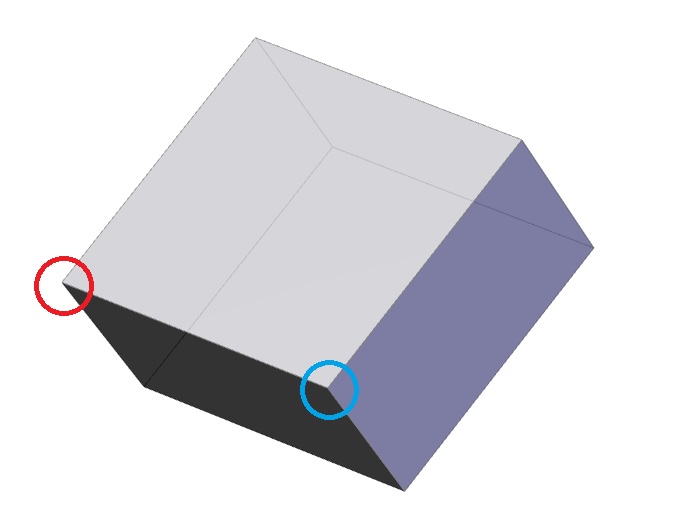
|
_________________
Pablo Rodríguez Cantos
Λίθον˛ον απεδοκίμασαν˛οι οικοδομουντες |
|
| Back to top |
|
 |
Pete Richards
Site Admin

Joined: 29 Dec 2008
Posts: 828
Location: Northeast Ohio



|
 Posted: May 07, 2015 12:55 Post subject: Re: Miller-Bravais Indices: really necessary? Posted: May 07, 2015 12:55 Post subject: Re: Miller-Bravais Indices: really necessary? |
|
|
Sorry to be so long in replying - other activities intervened!
Below is a rhombohedron; it happens to be the cleavage rhombohedron of calcite. The top drawing shows the hexagonal axis set, with a unique (three-fold) vertical axis and three equivalent horizontal axes 120° apart from each other.
The bottom drawing shows the same rhombohedron with the rhombohedral axis set, composed of three equal axes all separated by an angle alpha. In this case the rhombohedron is congruent with the unit cell, so the axes are parallel to the edges of the rhombohedron. One possible set of axes would be the three upper edges, another possible set would be the three bottom edges. One of these sets would be the negatives of the other set, though really the axes should be though of as extending in both directions from the origin, which I placed at the center of the crystal.
| Description: |
|
| Viewed: |
14663 Time(s) |
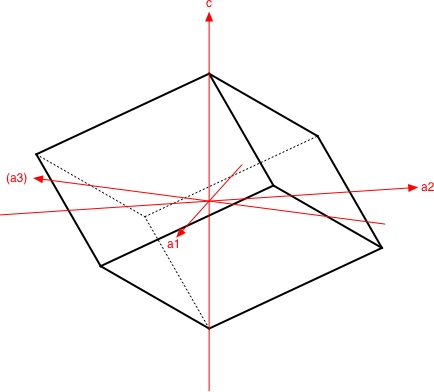
|
| Description: |
|
| Viewed: |
14520 Time(s) |
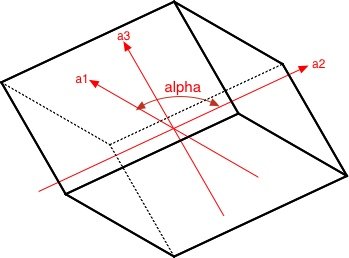
|
_________________
Collecting and studying crystals with interesting habits, twinning, and epitaxy |
|
| Back to top |
|
 |
Pete Richards
Site Admin

Joined: 29 Dec 2008
Posts: 828
Location: Northeast Ohio



|
 Posted: May 07, 2015 14:49 Post subject: Re: Miller-Bravais Indices: really necessary? Posted: May 07, 2015 14:49 Post subject: Re: Miller-Bravais Indices: really necessary? |
|
|
| prcantos wrote: |
I don't know if I have understood the two possible choices for the origin of the frame of reference. Are they those I have marked in the picture? The red circle defines an 'acute' trihedral angle (three acute angles in the same vertex), the blue circle defines an 'obtuse' one (at least one obtuse plain angle). |
I was interested in the spots you identified and your description of them. I think, in fact, that every vertex around the middle of the crystal must have either two obtuse angles and one acute angle or vise versa. Consider the following and see the diagram below. If the rhombohedron is squat (flattened relative to a cube set on its corner) as in this drawing, the three angles around the top and bottom (intersecting the c axis) will all be obtuse. By the geometry of a rhomb, the corners opposite from these across the face must also be obtuse and equiangular with these. Then the remaining two faces must be acute, since the sum of the angles is 360°. This is true for every face on the crystal. This results in an obtuse angle opposite two acute angles at each equatorial vertex.
If the rhombohedron is steep, steeper than a cube, the exact opposite result is obtained - one acute angle opposite two obtuse angles at each equatorial vertex.
The diagram is a little confusing at first. The dashed edges are, of course, on the back of the crystal. Similarly, the grey letters represent angles on the back of the crystal. "O", of course, indicates obtuse and "a" indicates acute.
| Description: |
|
| Viewed: |
14507 Time(s) |
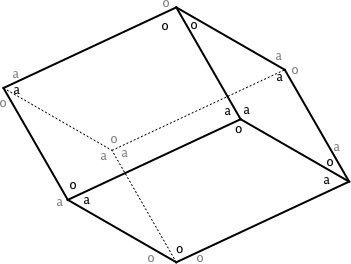
|
_________________
Collecting and studying crystals with interesting habits, twinning, and epitaxy |
|
| Back to top |
|
 |
prcantos
Site Admin
Joined: 17 Apr 2012
Posts: 243
Location: Granada (Spain)



|
 Posted: May 07, 2015 16:00 Post subject: Re: Miller-Bravais Indices: really necessary? Posted: May 07, 2015 16:00 Post subject: Re: Miller-Bravais Indices: really necessary? |
|
|
Ok, thank you, Peter. What an eye for 3D graphics! You are right with the angles in the rhombohedron.
_________________
Pablo Rodríguez Cantos
Λίθον˛ον απεδοκίμασαν˛οι οικοδομουντες |
|
| Back to top |
|
 |
|


